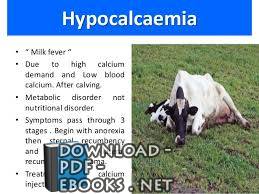📘 ❞ Factors Affecting the Success Rate of Treatment of Recumbent Dairy Cows Suffering from Hypocalcaemia ❝ كتاب
كتب طب بيطرى - 📖 كتاب ❞ Factors Affecting the Success Rate of Treatment of Recumbent Dairy Cows Suffering from Hypocalcaemia ❝ 📖
█ _ 0 حصريا كتاب ❞ Factors Affecting the Success Rate of Treatment Recumbent Dairy Cows Suffering from Hypocalcaemia ❝ 2024 Hypocalcaemia: من كتب طب بيطرى CLINICAL MEDICINE Department for Farm Animals and Herd Management, University Veterinary Medicine Vienna, Austria Factors Suffering from Hypocalcaemia C C Gelfert 1,3 , I Alpers 2 , M Dallmeyer 2 , M Decker 2 , A Hu ̈ ting 2 , S Lesch 2 , W Baumgartner 1 and R Staufenbiel 2 Addresses authors: 1 Department Clinic Ruminants, Veterinary Medicine 1210 Austria; 2 Clinic Ruminants Swine, Free Berlin, 14163 Germany; 3 Corresponding author: Tel : +43 1 25077 5215; fax: 5290; E mail: Carl Christian Gelfert@vu wien ac at With 10 tables Received publication April 3, 2006 Summary We aimed to investigate ratio accompanying diseases in cows suffering clinical hypocalcaemia their influence on cure rate In five veterinary practices in different regions of Germany, all recumbent cows around parturition were included in study a period year After recording case history examination was done serum sample was taken measure concentrations calcium phosphorus magnesium, b hydroxybutyrate, total bilirubin, cholesterol, urea, activities ASAT, CK, GLDH Only cows with entered statistical analysis Hypocal caemia major cause recumbency sec ond lactation or elder Muscle damage second frequent diagnose concomitant disease in hypocalcaemic The overall between 89 4% 94 8% Calcium phosphorus did not have an influence on Non cured had higher serum CK (p<0 043) ASAT 006) Nevertheless, no good predictors treatment failure because low specificity and high Introduction Hypocalcaemia is still dairy becoming recumbent peripartal (Shpigel et al , 2003; Gelfert et 2004, 2005) onset increases calcium requirement (Goff Horst, 1997) If mobilization of calcium bones intestine fails compensate for the loss milk, plasma concen trations will become too be able support nerve and muscle function 1997; Goff, 2004) It still recommended treat such animals with intravenous infusion organic solutions (Staufenbiel, 1999; Martig, 2002) However, prior recumbent cow, detailed must made order to exclude other possible causes cow main differential diagnoses vary disorders musculoskel etal system (traumatic injuries, bone fracture), neural disorders (e g obturator paralysis) metabolic due mineral deficiencies (e hypomagnesaemia, hypocalcaemia), energy deficiency, hepatic (Dirksen, Other possible differential are toxic metritis, mastitis, ileus, and shock rupturing intestine, abomasal ulcer, generalized peritonitis 2002; Hunt and Blackwelder, Depending occurrence a disturbed sensorium disturbed general health the parturient cows, differential the field, possibilities are often limited, which symptoms either not clearly visible non specific (Bostedt 1979; Stolla 2000) Metzner Klee (2005) showed that signs not specific particular mineral deficiency or phosphorus) They also found classical symptom of hypocalcaemia, sensorium, less severe than previous studies (Malz Meyer, 1992) Therefore, a given uncertainty remains after examination, in which examining veterinarian choose treatment with highest probability success Recent papers reported decreased after the first standard therapy (Meschke, 1997; Abele Wolf, 2000; Roesch, Some of them assume increased prevalence recumbent cows hypophosphataemia may contribute the impaired (Abele , 2000) (2000) assumed preval ence creatinkinase (CK) activity first therapy, but he did prove it authors found significant differences different treatment outcomes (Gelfert Unsuccessfully treated higher aspartate amino transferase (ASAT) than ones It unknown whether factors the hypocalcaemia impact curing recumbent dairy مجاناً PDF اونلاين الطب البيطري (بالإنجليزية: medicine) أو البيطرة هو تطبيق المبادئ الطبية والتشخيصية والعلاجية الحيوانات الإنتاجية والمنزلية والبرية يحتوي هذا القسم علي العديد الكتب المتميزة حول المجال يمارس عادة عيادة بيطرية مستشفى بيطري المزرعة للطب دور كبير حماية البشر الأمراض التي تنتقل عن طريق الأكل أصبح التخصص شائعاً السنوات الأخيرة ومن تلك التخصصات: التخدير علم السلوك الجلدية الحالات الطارئة والعناية الحثيثة الباطني امراض القلب السرطان العيون الأعصاب المشتركة المعدية التناسليات والولادة التصوير الشعاعي والجراحة

كتاب
Factors Affecting the Success Rate of Treatment of Recumbent Dairy Cows Suffering from Hypocalcaemia

كتاب
Factors Affecting the Success Rate of Treatment of Recumbent Dairy Cows Suffering from Hypocalcaemia
Factors Affecting the Success Rate of Treatment of Recumbent Dairy Cows Suffering from Hypocalcaemia من كتب طب بيطرى
CLINICAL MEDICINE
Department for Farm Animals and Herd Management, University of Veterinary Medicine Vienna, Vienna, Austria
Factors Affecting the Success Rate of Treatment of Recumbent Dairy Cows Suffering
from Hypocalcaemia
C.-C. Gelfert
1,3
,
I. Alpers
2
,
M. Dallmeyer
2
,
M. Decker
2
,
A. Hu
̈
ting
2
,
S. Lesch
2
,
W. Baumgartner
1
and
R. Staufenbiel
2
Addresses of authors:
1
Department for Farm Animals and Herd Management, Clinic for Ruminants, University for Veterinary
Medicine Vienna, 1210 Vienna, Austria;
2
Clinic for Ruminants and Swine, Free University Berlin, 14163 Berlin, Germany;
3
Corresponding author: Tel.: +43 1 25077 5215; fax: +43 1 25077 5290; E-mail: Carl-Christian.Gelfert@vu-wien.ac.at
With 10 tables
Received for publication April 3, 2006
Summary
We aimed to investigate the ratio of accompanying diseases in
cows suffering from clinical hypocalcaemia and their influence
on cure rate. In five veterinary practices in different regions of
Germany, all recumbent cows around parturition were included
in the study for a period of 1 year. After recording the case
history a clinical examination was done and a serum sample was
taken to measure the concentrations of calcium and phosphorus
magnesium,
b
with hypocalcaemia entered the statistical analysis. Hypocal-
caemia was the major cause of recumbency in cows of the sec-
ond lactation or elder. Muscle damage was the second frequent
diagnose in recumbent cows and the major concomitant disease
in hypocalcaemic cows. The overall cure rate was between
89.4% and 94.8%. Calcium and phosphorus concentrations did
not have an influence on cure rate. Non-cured cows had higher
serum activities of CK (p
